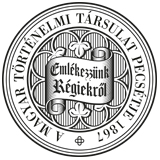Századok – 2014
KÖZLEMÉNYEK - Fedeles Tamás: "Medicina contra peccata mundana" Késő középkori főúri misealapítványok II/443
468 FEDELES TAMÁS Tudományos Akadémia Művészettörténeti Kutató csoportjának forráskiadványai X., XIII., XIV) Bp. 1975-1978. Détschy 1998 = Détshy Mihály. Az utolsó Pálóci végrendelete. In: Tanulmányok Borsa Iván tiszteletére. Szerk. Csukovits Enikő. Bp. 1998. 37-44. Dvoráková 2009 = Daniela Dvoráková: A lovag és királya. Stiborici Stibor és Luxemburgi Zsigmond. Pozsony 2009. ETE = Egyháztörténeti emlékek a magyarországi hitújítás korából, I-V Szerk. Bunyitai Vince, Rapaics Rajmund, Karácsonyi János, Kollányi Ferenc, Lukcsics József. Bp. 1902-1912. Füssy 1901= Füssy Tamás: Akosházi Sárkány Ambrus végrendelete 1522. évből. Történelmi Tár 24. (1901) 137-146. Héderváry = A Héderváry család oklevéltára I—II. Közli: Radvánszky Béla-Závodszky Levente. Bp. 1909-1922. Karácsonyi = Karácsonyi János: Szt. Ferenc rendjének története Magyarországon 1711-ig I—II. Bp. 1922-1924. Kelényi 2012 = Kelényi Borbála: Kanizsai Dorottya végrendelete és a bajcsi pálsoknak tett adományai. Fons 19. (2012) 495-529. LK 1925 etc. = Mályusz Elemér: A szlavóniai és horvátországi középkori pálos kolostorok oklevelei az Országos Levéltárban. I: Levéltári Közlemények ( = LK) 3. (1925) 100-191; II: LK 5. (1927) 136-209; III: LK 6. (1928) 87-203; IV: LK 7. (1929) 278-311; V: LK 8. (1930) 65-111; VI: LK 9. (1931) 284-315; VII-VIII: LK 10. (1932) 92-123, 256-286.; IX: LK 11. (1933) 58-92; X: LK 12. (1934) 111-154; XI: LK 13. (1935) 233-265. Podmaniczky = A podmanini Podmaniczky-család oklevéltára, I—II. Közzétette családtörténeti bevezetéssel és jegyzetekkel ellátta Lukinich Imre. Bp. 1937-1939. „MEDICINA CONTRA PECCATA MUNDANA” Baronial mass-endowments in the late Mediaeval Period by Tamás Fedeles (Abstract) In comparison with their status and financial situation, people of the Mediaeval Period exerted to insure the way of salvation for themselves as well as for their ancestors and descendants. One possible means to this was provided by mass-endowments. This study is based on the analysis of altogether 85 mass-endowments of 34 Hungarian aristocratic families (1406-1531). Besides those persons, who were owners of baronial dignities, their family members, particularly their widows and descendants are studied in this research work. The primary aim of the endowed masses was the establishment of the inner peace of the deceased person in the transitional period between life and death, which was aimed to insure by the continuity of services and prayers. This was considered to be realisable with the help of endowments which had been created for eternal time (temporibus perpetuis). This is proved by the fact that the majority (97.6%) of service orderings analysed are given by the eternal mass-endowments. Daily services were the most popular among the founders, which were followed by those that had been celebrated on a weekly frequency. Although, sometimes even more services were ordered a week, this cannot be considered as typical for the Hungarian aristocracy. The number of annual and anni-
